WALL.E (U)
Earth is an abandoned rubbish tip void of life ... enter WALL.E, a futuristic Robot-son Crusoe with a hint of Woody Allen

Your support helps us to tell the story
In my reporting on women's reproductive rights, I've witnessed the critical role that independent journalism plays in protecting freedoms and informing the public.
Your support allows us to keep these vital issues in the spotlight. Without your help, we wouldn't be able to fight for truth and justice.
Every contribution ensures that we can continue to report on the stories that impact lives

Kelly Rissman
US News Reporter
One of the best jokes in WALL•E, the new digital animation from Pixar, is the end-credits sequence, which gives us the history of figurative art in a nutshell. A series of animated pastiches takes us from cave painting to the present, through ancient Egypt, the Renaissance, Turner and Seurat, all the way to ... Pacman. The entire development of image-making, to end in this: a few coloured dots running around a screen? Yet a handful of dots is Pixar's stock in trade, and the single dot – the pixel – which is computer animation's building block, has spawned cinema's most sophisticated image technology yet.
It's just over 20 years since the Pixar pioneer, John Lasseter, started combining those dots to tell simple stories about animated household objects. Now CGI animation has attained the photo-realist complexity seen in WALL•E, which is Pixar's most elegant film to date, but also its subtlest and richest.
Ostensibly a children's comedy about a lonely little robot, WALL•E is philosophical sci-fi with a depth that eludes most of Hollywood's adult output. It's Pixar's most emotionally satisfying production, yet human presence in it is sidelined while the machines take centre stage: its hero is a rusty metal box on Caterpillar treads, and the villain is a steering wheel.
Strikingly melancholy, WALL•E, directed and co-written by Andrew Stanton, is surely the only children's animation ever to open with an image of apocalyptic desolation. After zooming in from space on to an Earth belted with floating junk, the imaginary camera scans a wasteland, our planet's surface reduced to one vast rust-brown landfill site. There's only one living being left in this desolation, and he's not strictly living: a stout little device named WALL•E (Waste Allocation Load Lifter Earth-Class). WALL•E is the planet's last functioning robot, its purpose – "his" purpose, if you'll pardon the anthromorphism – to tidy up the debris. Earth has been abandoned for centuries, ever since all-powerful supermarket conglomerate BNL (Buy-N-Large) reduced the globe to this condition. BNL's hologram adverts, echoing Blade Runner's, still play eternally to an audience of one; they feature Pixar's first use of live-action footage, featuring Fred Willard, the ineffable master of unsinkable all-American idiocy.
The last of an obsolete robot race, WALL•E daily trundles through his duties. The faithful servant doggedly carrying on when the masters have bailed out: it's a terribly poignant image, as seen in the first shots of WALL•E rolling through the blasted land, accompanying himself with a taped selection from that forgotten and unloved movie musical Hello, Dolly!.
Meanwhile, WALL•E shores fragments of human culture: in his dump-truck home, he collects plastic cutlery, rubber ducks, garden gnomes. But this dustpile Crusoe isn't alone for long. One day another automaton descends from the sky: an opalescent egg-shaped thing named EVE, a glowing spectral wonder with arms and fingers that float free in mid-air, then vanish magically into her body.
WALL•E and EVE make a complementary pair – robotry of the nuts-and-bolts past, and of the streamlined virtual future – and they eventually nurture a robo-romance. But this cybernetic cute-meet is never mawkish or Bambi-esque. It's because the film dispenses with any obvious human elements in their make-up that it paradoxically succeeds in giving its robots the semblance of real emotion. John Lasseter copped out in 2006's Cars by giving its automobile characters funny windshield faces, but WALL•E rises to the challenge of robotic form. Its hero's physiognomy never changes: the binoculars that serve him as "eyes" simply shift position, making him seem as anxious as Woody Allen or as innocent as Harold Lloyd. A glimmer of reflection in his lenses can make him seem wistful or depressed, but it's all done with light: you can tell that much research has gone into the ways we perceive expression, and that's the perfectionist edge that Pixar has over the broader cartoonish work of its rivals.
The film's first third represents Pixar's most daring achievement yet. It depicts a place voided of human presence, a bleak vision breathtakingly conceived: in its image of a purely robotic world, WALL•E, rather than Spielberg's AI, is the true inheritor of Stanley Kubrick's futurism. This opening sequence is almost entirely wordless: speech is replaced by electronic bleeps and chirrups, punctuated by the odd skittering noise from WALL•E's cockroach sidekick, all fabricated by sound designer Ben Burtt. It's just a shame that the film didn't trust to the soundscape and dispense with music entirely: it would have been perfect.
The sublime first act develops a strain of delicate visual humour in which WALL•E is magically imbued with E.T.'s vulnerability, Buster Keaton's balletic panache, Jacques Tati's minimalist comic sensibility. Things shift gear when the action moves to a holiday-camp space station, where humans have degenerated into pampered, barely functional blobs in romper suits. Beneath the bright candy hues of this satire is a horrifying insight into the way that consumerism infantilises and disables us. If the film's rubbery lumps of humanity seem blandly featureless, that's the point: coddled into submission, they've lost their reality, their texture.

Watch Apple TV+ free for 7 days
New subscribers only. £8.99/mo. after free trial. Plan auto-renews until cancelled

Watch Apple TV+ free for 7 days
New subscribers only. £8.99/mo. after free trial. Plan auto-renews until cancelled
The film is least distinctive when in space-adventure mode – the slapstick gets messily frantic – but there are still touches of astonishing beauty, displaying the sheer grace that digital style can aspire to. The two robots' free-fall duet with a fire extinguisher is as rapturous a comic ballet as Chaplin's skating in The Rink.
WALL•E is a beautiful riposte to the bombastic faux-sophistication of so much CGI razzle-dazzle. Take the oppressively flashy design of Transformers, spinning a line of robot toys into a film. Where its creations frenet-ically whizz-bang themselves into cars, planes, endless variations of martial hardware, WALL•E is a Transformer of Zen simplicity: a robot who folds himself into a rusty box. One elegant sight gag involves a Rubik's Cube, and there you have a perfect image of the film's brilliance. At once fiendishly complex and breathtakingly simple, WALL•E is also made of coloured blocks, recombined in infinite variations and more fascinating than you'd think possible.
Need to know
Pixar Animation Studios led the field in computer-generated imagery in the 1980s with early shorts from co-founder John Lasseter (pictured below) including 'Tin Toy', 'Knick Knack' and the 1986 'Luxo Jr', which starred the Anglepoise lamp that became the company's logo. 'Toy Story' (1995) made history as the first all-CGI animation feature, and the company followed up with 'A Bug's Life', 'Toy Story 2', 'Monsters, Inc', 'Finding Nemo' and 'The Incredibles'. The company's dud, arguably, is the uncharacteristically strident gas-guzzler 'Cars' – after which last year's 'Ratatouille' was a return to gourmet form. Pixar also make shorts to preface their features: accompanying WALL•E is 'Presto', about the war of attrition between a magician and his rabbit.
Subscribe to Independent Premium to bookmark this article
Want to bookmark your favourite articles and stories to read or reference later? Start your Independent Premium subscription today.
Join our commenting forum
Join thought-provoking conversations, follow other Independent readers and see their replies
Comments